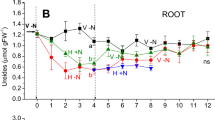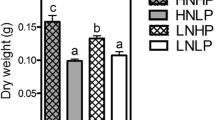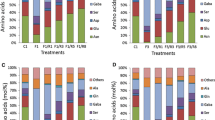Abstract.
The NADH-dependent nitrate reductase (NR, EC 1.6.6.1) in roots of hydroponically grown barley seedlings was extracted, desalted and the activity measured in buffer containing either Mg2+ (10 mM) or EDTA (5 mM). The former gives the actual NR activity (NRact) equivalent to dephospho-NR, whereas the latter gives the maximum NR capacity of the dephospho-form (NRmax). Both values together permit an estimation of the NR-phosphorylation state. Changes in NRact and NRmax were followed in response to root aeration or to shoot illumination or shoot removal, and were correlated with sugar contents and adenylate levels. Ethanol formation was also measured in roots differing in NR activity in order to obtain information on the relation between anaerobic alcoholic fermentation and nitrate reduction. In aerated roots, NR was highly phosphorylated (about 80%) and largely inactive. It was partly dephosphorylated (activated) by anoxia or by cellular acidification (pH 4.8 plus propionic acid). Anaerobic activation (dephosphorylation) of NR was stronger at acidic external pH (5) than at slightly alkaline pH (8), although ATP levels decreased and AMP levels increased at pH 5 and at pH 8 to the same extent. Thus, rapid changes in the NR-phosphorylation state in response to anaerobiosis were not directly triggered by the adenylate pool, but rather by cytosolic pH. Under prolonged darkness (24 h) or after shoot removal, NRmax decreased slowly without a large change in the phosphorylation state. This decrease of NRmax was correlated with a large decrease in the sugar content, and was prevented by glucose feeding, which had only minor effects on the phosphorylation state. Cycloheximide also prevented the decrease in NRmax without affecting the phosphorylation state. In contrast, anaerobiosis or cellular acidification prevented the decrease of NRmax and at the same time decreased the NR-phosphorylation state. It is suggested that NR turnover in roots is controlled by several factors: NR synthesis appears to depend on sugar availability, which has little effect on the phosphorylation state; in addition, NR degradation appears to be strongly affected by the phosphorylation state in such a way that the inactive phospho-NR is a better substrate for NR degradation than the dephospho-form. The rate of anaerobic ethanol formation was not affected by NR activity, indicating that the purpose of NR activation under hypoxia or anoxia is not to decrease or prevent alcoholic fermentation.
Similar content being viewed by others
Author information
Authors and Affiliations
Additional information
Received: 29 August 1996 / Accepted: 8 November 1996
Rights and permissions
About this article
Cite this article
Botrel, A., Kaiser, W. Nitrate reductase activation state in barley roots in relation to the energy and carbohydrate status. Planta 201, 496–501 (1997). https://doi.org/10.1007/s004250050094
Issue Date:
DOI: https://doi.org/10.1007/s004250050094




